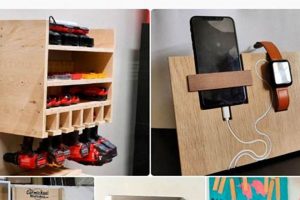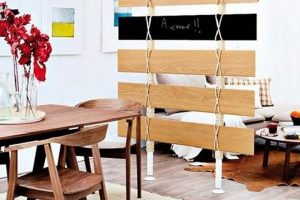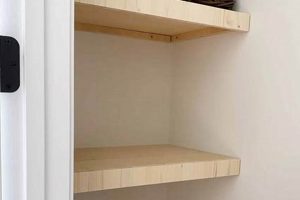Constructing a bathroom sink cabinet through do-it-yourself methods encompasses a range of projects, from repurposing existing furniture to building a completely new structure. These endeavors offer homeowners avenues to customize their bathroom spaces while potentially reducing renovation expenses. An example of this would be transforming an old dresser into a unique focal point within the bathroom.
The practice of creating personalized bathroom fixtures provides numerous advantages, including cost savings, customization options, and the satisfaction of crafting a unique piece. Historically, homeowners have sought ways to personalize their living spaces, and this extends to bathroom design. Employing self-directed building methods allows individuals to control material selection, dimensions, and aesthetic details, resulting in a bathroom more closely aligned with personal preferences and functional needs. Furthermore, repurposing materials can reduce waste and contribute to environmentally conscious home improvement.
This article will explore specific methods and considerations for realizing a customized bathroom sink area. Topics covered will include project planning, material selection, construction techniques, and finishing options, providing practical guidance for homeowners seeking to undertake such projects.
Tips for Implementing Customized Bathroom Sink Units
Successful execution of self-directed bathroom sink construction requires careful planning and attention to detail. The following tips provide guidance for achieving optimal results.
Tip 1: Precise Measurement is Paramount: Accurate measurements of the bathroom space, plumbing locations, and chosen fixtures are critical to prevent errors and ensure proper fit.
Tip 2: Material Selection Influences Longevity: Choose water-resistant materials, such as treated wood, solid-surface materials, or specific types of tile, to prevent damage from moisture exposure.
Tip 3: Prioritize Functionality in Design: Consider storage needs, countertop space, and ergonomic factors when designing the unit to optimize usability.
Tip 4: Employ Secure Construction Techniques: Utilize appropriate joinery methods, such as screws, dowels, or pocket-hole joinery, to ensure structural integrity and prevent instability.
Tip 5: Plan for Plumbing Accessibility: Design the unit to allow easy access to plumbing connections for future maintenance or repairs. Incorporate removable panels or access doors as needed.
Tip 6: Finishing Enhances Aesthetics and Protection: Apply appropriate sealants, paints, or stains to protect the materials from moisture and enhance the visual appeal of the finished piece.
Tip 7: Compliance with Building Codes is Essential: Research and adhere to local building codes and regulations regarding plumbing and electrical work to ensure safety and legality.
Adherence to these guidelines will contribute to a durable, functional, and aesthetically pleasing bathroom sink area.
The following sections will provide more in-depth explorations of construction techniques and finishing options.
1. Repurposed furniture
Repurposed furniture serves as a foundational element within the broader scope of do-it-yourself bathroom sink construction. This practice involves adapting existing furniture pieces, typically designed for other rooms, into functional sink bases within the bathroom environment. The effect of utilizing repurposed items is multifaceted, impacting cost, aesthetics, and sustainability. The inherent value of repurposed furniture lies in its potential to reduce material expenses, introduce unique design elements, and minimize waste through upcycling. For example, a vintage dresser, with its drawers and solid construction, can be transformed into a charming and functional sink base with minimal modification, offering significant cost savings compared to purchasing a new unit.
The importance of repurposed furniture in self-directed bathroom sink construction extends beyond mere cost reduction. It allows for a level of customization and personalization often unattainable with mass-produced products. The existing character of the furniture, including its patina, hardware, and inherent design, can be incorporated into the bathroom’s overall aesthetic. This approach fosters creativity and individuality, resulting in a space that reflects the homeowner’s personal style. Furthermore, the process of adapting furniture for a new purpose encourages resourcefulness and problem-solving skills, empowering homeowners to take control of their renovation projects.
However, the successful integration of repurposed furniture requires careful consideration of practical factors. Plumbing integration, structural integrity, and moisture resistance are crucial aspects that must be addressed. Modifications may be necessary to accommodate plumbing lines and ensure the furniture can withstand the humid environment of a bathroom. Despite these challenges, the rewards of repurposing furniture in self-directed bathroom sink creation are significant, offering a unique blend of cost-effectiveness, creative expression, and environmental responsibility.
2. Material Selection
Material selection constitutes a critical juncture within self-directed bathroom sink construction projects. The materials chosen directly influence the unit’s longevity, resistance to moisture damage, aesthetic appeal, and overall structural integrity. Inadequate material selection can result in premature failure, aesthetic degradation, and potential health hazards due to mold or rot. For instance, utilizing untreated particleboard in a bathroom sink cabinet would lead to rapid swelling and disintegration upon exposure to water, rendering the entire project unsustainable. Conversely, employing marine-grade plywood or solid hardwood, coupled with appropriate sealants, provides enhanced protection against moisture and extends the lifespan of the sink structure.
The influence of material choices extends beyond purely functional considerations. The selected materials significantly contribute to the overall aesthetic of the bathroom. Options range from rustic reclaimed wood, imparting a warm and textured feel, to sleek and modern solid-surface materials, offering a minimalist and hygienic appearance. The choice of countertop material, such as granite, quartz, or concrete, further impacts the aesthetic and functional properties of the sink area. A granite countertop, for example, provides durability and resistance to staining, while concrete offers a customizable and contemporary look. The interplay between these materials creates a cohesive and visually appealing design that complements the existing bathroom decor.
Therefore, a comprehensive understanding of material properties and their suitability for the bathroom environment is essential for successful imp
lementation of self-directed bathroom sink projects. Careful consideration of moisture resistance, durability, aesthetic appeal, and cost-effectiveness guides the selection process, resulting in a functional, aesthetically pleasing, and long-lasting bathroom fixture. The challenges associated with incorrect material selection highlight the practical significance of thorough research and informed decision-making within this aspect of home improvement.
3. Plumbing Integration
Plumbing integration represents a critical phase within the execution of self-directed bathroom sink construction. This phase entails the connection of water supply and drainage systems to the newly constructed or repurposed sink unit. Improper plumbing integration can lead to leaks, water damage, and potential health hazards, underscoring its paramount importance to project success.
- Drainage System Connection
Effective drainage necessitates precise alignment and secure connections between the sink drain, the P-trap, and the drainpipe leading to the main plumbing system. Misalignment or loose connections can result in water leakage and the release of noxious sewer gases into the bathroom environment. A common example involves insufficient tightening of the P-trap fittings, leading to slow leaks that can damage the cabinet structure over time. Proper installation, adhering to plumbing codes and employing appropriate sealants, is essential for preventing such issues.
- Water Supply Line Installation
Connecting the water supply lines to the faucet requires careful attention to prevent leaks and ensure adequate water pressure. Copper, PEX, or braided stainless steel supply lines are commonly employed, each demanding specific connection techniques. Over-tightening fittings can damage the faucet or supply lines, while insufficient tightening can lead to leaks. Furthermore, the installation of shut-off valves on both hot and cold water supply lines is crucial for facilitating future maintenance and repairs without disrupting the entire water supply.
- Adherence to Plumbing Codes
Plumbing codes dictate specific requirements for pipe diameter, venting, and backflow prevention to ensure safe and efficient operation of the plumbing system. Failure to comply with these codes can result in fines, mandatory rework, and potential health hazards. For example, improper venting can lead to the siphoning of water from the P-trap, allowing sewer gases to enter the bathroom. Therefore, thorough understanding and adherence to local plumbing codes are essential for any self-directed plumbing work.
- Leak Testing and Prevention
Upon completion of the plumbing connections, comprehensive leak testing is imperative. This involves thoroughly inspecting all connections for any signs of water leakage. Common leak points include faucet connections, supply line fittings, and drain connections. Addressing any leaks promptly prevents water damage and ensures the long-term integrity of the bathroom sink unit. The use of pipe joint compound or Teflon tape on threaded connections further minimizes the risk of leaks.
These facets of plumbing integration are integral to the successful realization of a do-it-yourself bathroom sink. Attention to detail, adherence to plumbing codes, and rigorous leak testing contribute to a functional, safe, and durable plumbing system within the constructed sink unit. The integration should be a carefully planned and executed process.
4. Storage Optimization
Storage optimization within self-directed bathroom sink construction is a crucial consideration, directly impacting the functionality and usability of the bathroom space. The design and implementation of effective storage solutions within a self-built sink unit can significantly enhance organization, reduce clutter, and maximize the available space. Careful planning and innovative design are essential to transforming a standard sink area into a highly functional storage hub.
- Drawer Configuration and Customization
Drawer design allows for compartmentalization of toiletries, cleaning supplies, and other bathroom essentials. Customizing drawer sizes and configurations to suit specific storage needs is essential. For example, incorporating narrow drawers for makeup or wider drawers for towels can optimize space utilization. The use of drawer dividers and organizers further enhances efficiency by preventing items from shifting and creating a more orderly storage environment. Incorporating soft-close mechanisms can enhance usability.
- Shelving Integration and Accessibility
Open or closed shelving provides accessible storage for frequently used items, such as hand towels, soap, and decorative accessories. Adjustable shelving allows for flexible storage solutions, accommodating items of varying sizes. Open shelving can visually expand the space, while closed shelving can conceal clutter and provide a more streamlined appearance. Positioning shelves strategically within the sink unit ensures easy access to commonly used items, promoting efficiency and convenience.
- Vertical Space Utilization
Maximizing vertical space within the bathroom is particularly important in smaller bathrooms where floor space is limited. Tall, narrow cabinets or shelving units can effectively utilize vertical space, providing ample storage without occupying excessive floor area. Incorporating over-the-toilet storage or utilizing wall-mounted cabinets above the sink can further expand storage capacity. Strategic use of mirrors on cabinet doors can also create the illusion of more space while providing additional functionality.
- Hidden Storage Solutions
Integrating hidden storage solutions can effectively conceal clutter and maintain a clean and organized appearance. Tilt-out drawers for storing small items, pull-out hampers for laundry, or false drawer fronts concealing cleaning supplies are examples of hidden storage options. Integrating a shallow cabinet behind the sink mirror can provide concealed storage for toothbrushes and other personal care items. These discreet storage solutions contribute to a minimalist aesthetic while maximizing storage capacity.
Effective storage optimization within self-directed bathroom sink construction directly enhances the functionality and aesthetic appeal of the bathroom. The implementation of customized drawers, strategic shelving, maximized vertical space, and concealed storage solutions transforms a standard sink area into a highly organized and efficient space. Thoughtful design considerations are key. This allows for storage needs to be met while creating a visually appealing and functional bathroom environment.
5. Countertop Choice
The selection of a countertop material is a pivotal decision within the context of do-it-yourself bathroom sink projects. Countertop choice affects not only the aesthetic appearance of the vanity but also its durability, functionality, and long-term maintenance requirements. A direct correlation exists between the quality and suitability of the chosen
countertop and the overall success of the self-directed bathroom sink endeavor. For instance, selecting a porous material like untreated wood would result in water damage and eventual deterioration, rendering the sink unusable. Conversely, a durable, non-porous material such as quartz or granite would offer superior resistance to moisture, stains, and scratches, prolonging the lifespan of the unit.
The importance of informed countertop decisions extends beyond mere practicality. The countertop serves as a focal point within the bathroom, contributing significantly to the overall design aesthetic. Materials such as marble or granite introduce an element of luxury and sophistication, while concrete offers a more industrial or contemporary look. Laminate countertops provide a cost-effective and versatile option, available in a wide range of colors and patterns. Each material presents a unique set of advantages and disadvantages concerning cost, durability, maintenance, and aesthetic appeal. Understanding these factors is critical for making informed choices that align with individual needs, budget constraints, and desired aesthetic outcomes. For example, a smaller bathroom might benefit from a lighter-colored countertop to enhance the perception of space, while a larger bathroom could accommodate a darker, more dramatic choice.
In conclusion, countertop choice is an integrated component of do-it-yourself bathroom sink projects. The selection process requires a comprehensive understanding of material properties, functional requirements, and aesthetic considerations. Addressing potential challenges, such as budget constraints or material limitations, is essential for achieving a successful outcome. Ultimately, a well-chosen countertop contributes significantly to the functionality, durability, and visual appeal of the self-constructed bathroom sink, enhancing the overall value and enjoyment of the bathroom space. The understanding is highly practical.
6. Style Alignment
Style alignment, in the context of do-it-yourself bathroom sink projects, signifies the cohesive integration of the newly constructed or repurposed unit with the existing aesthetic of the bathroom. A lack of style alignment can result in a jarring visual disconnect, diminishing the overall appeal of the space and potentially reducing its perceived value. The practical significance of style alignment stems from its ability to create a harmonious and visually pleasing environment, enhancing the user experience and contributing to a sense of well-being. For example, a modern, minimalist vanity constructed with sleek, white materials would clash sharply with a bathroom designed in a rustic, farmhouse style, characterized by exposed wood beams and antique fixtures. Conversely, incorporating reclaimed wood and distressed finishes into a self-built vanity for a farmhouse-style bathroom would seamlessly integrate the new fixture with the existing design, creating a cohesive and aesthetically pleasing space. Style is often undervalued when the primary aim is functional, but ignoring Style Alignment is an error.
The process of achieving style alignment involves careful consideration of several factors, including color palettes, material choices, hardware finishes, and architectural details. Matching the color palette of the vanity to the existing wall color, flooring, or other prominent fixtures can create a sense of visual continuity. Selecting materials that complement the existing finishes, such as matching the wood species of the vanity to the existing trim work, further enhances the cohesive design. Hardware finishes, such as brushed nickel or oil-rubbed bronze, should be consistent with the other fixtures in the bathroom to maintain a unified aesthetic. Architectural details, such as the shape of the vanity doors or the style of the countertop edge, should also align with the overall design theme to avoid visual dissonance. For example, if a bathroom features a traditional, Victorian-style design, a vanity with ornate carvings, a marble countertop, and antique-inspired hardware would effectively align with the existing aesthetic. Such harmony is not automatically achieved.
In conclusion, style alignment is an indispensable consideration in do-it-yourself bathroom sink design, transforming what is built into something more. While construction skills and material choices are essential, failing to prioritize style alignment can undermine the overall success of the project. Challenges may arise from budget constraints or difficulty in sourcing materials that perfectly match the existing aesthetic, but careful planning and creative problem-solving can mitigate these issues. Ultimately, achieving style alignment results in a bathroom that feels cohesive, intentional, and visually appealing, enhancing the user experience and increasing the perceived value of the home. It is a consideration that will have lasting effects.
Frequently Asked Questions Regarding DIY Bathroom Vanity Ideas
The following section addresses common inquiries and misconceptions pertaining to the construction of bathroom sink units through do-it-yourself methods.
Question 1: Is prior carpentry experience necessary to construct a bathroom sink unit?
While prior carpentry experience is beneficial, it is not strictly mandatory. Individuals with limited experience can successfully complete such projects by utilizing detailed plans, seeking guidance from online resources, and starting with simpler designs. However, a foundational understanding of basic woodworking techniques is highly recommended.
Question 2: What are the primary considerations when selecting materials for a DIY bathroom sink unit?
Material selection should prioritize water resistance, durability, and aesthetic compatibility with the existing bathroom decor. Solid wood, treated plywood, and certain composite materials are suitable options. Countertop materials should be non-porous and resistant to staining.
Question 3: How can potential plumbing issues be minimized during a DIY bathroom sink installation?
Thorough planning, precise measurements, and adherence to local plumbing codes are crucial. It is advisable to consult with a licensed plumber if unfamiliar with plumbing techniques or if modifications to existing plumbing lines are required.
Question 4: What tools are typically required for constructing a bathroom sink cabinet?
Essential tools include a measuring tape, level, saw (circular or hand saw), drill, screwdriver, sandpaper, and appropriate safety equipment. Additional tools, such as a pocket-hole jig or router, may be necessary depending on the complexity of the design.
Question 5: How does one ensure adequate ventilation within a bathroom sink cabinet to prevent moisture buildup?
Proper ventilation can be achieved through the incorporation of ventilation holes or the installation of a small ventilation fan within the cabinet. Ensuring adequate spacing between stored items also promotes airflow.
Question 6: What are the potential cost savings associated with undertaking a DIY bathroom sink project compared to purchasing a pre-assembled unit?
Cost savings can be significant, particularly when repurposing existing materials or constructing a simple design. However, the total cost will depend on the materials chosen, the complexity of the design, and the level of prior experience. Consider the time investment. It affects overall affordability.
Careful planning, informed material selection, and adherence to safety guidelines are paramount
for the successful execution of a bathroom sink cabinet project.
The following section will summarize key takeaways for the article.
Conclusion
This article has explored the various facets of engaging in diy bathroom vanity ideas, focusing on critical aspects such as repurposed furniture, material selection, plumbing integration, storage optimization, countertop choice, and style alignment. Each component plays a vital role in the successful realization of a functional and aesthetically pleasing bathroom fixture. Proper planning, attention to detail, and adherence to safety guidelines remain paramount for any self-directed project.
The insights provided aim to empower individuals to undertake these projects with confidence, achieving cost savings, customization options, and the satisfaction of creating a unique addition to their homes. Further exploration into specific techniques and evolving design trends will continue to shape the landscape of this construction category.







